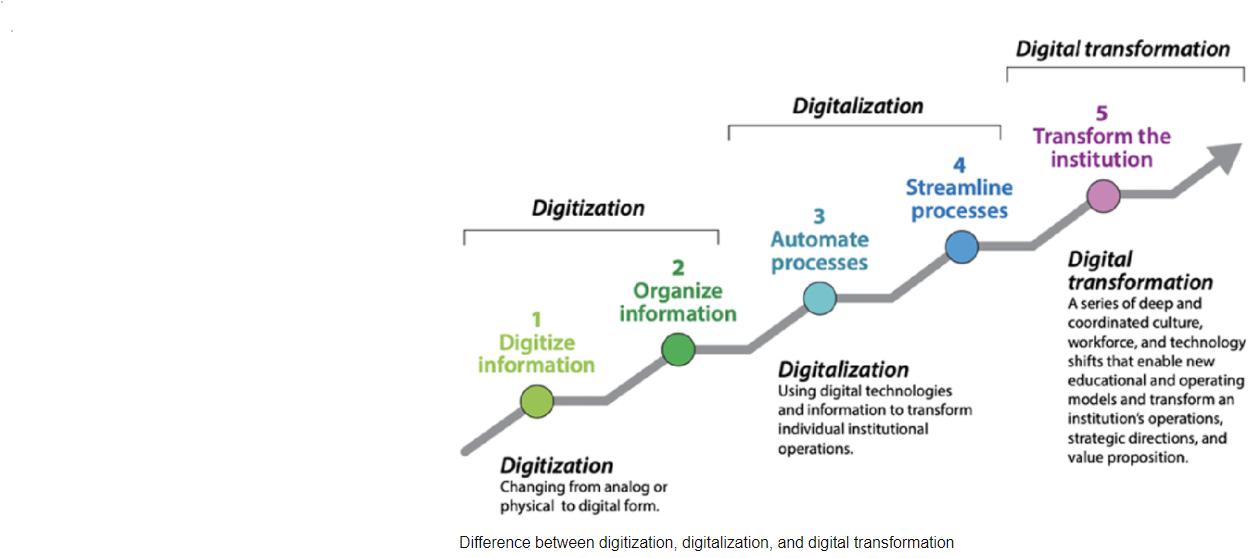In today’s digital age, businesses are under increasing pressure to adapt and leverage the latest digital technologies to stay competitive. However, the terms digitization, digitalization, and digital transformation are often used interchangeably, causing confusion about what they really mean. In this article, we will explain the differences between these three concepts and provide examples of how they are used in global corporations.
The Differences Between Digitization, Digitalization, and Digital Transformation:
- Digitization: Digitization refers to the process of converting analog information into digital form. For example, scanning a paper document to create a digital copy. Digitization is a foundational step in the digital transformation process, but it is not a transformation in itself. Instead, digitization is focused on converting existing analog assets into digital formats, such as photos, documents, and videos.
- Digitalization: Digitalization is the use of digital technologies to streamline business processes and improve efficiency. Digitalization involves using digital tools to automate and optimize existing processes, such as using software to manage inventory or using online platforms to connect with customers. Digitalization can improve business operations, but it does not necessarily lead to significant changes in business models or revenue streams.
- Digital Transformation: Digital transformation is the comprehensive and strategic use of digital technologies to transform how a business operates, delivers value to customers, and creates new revenue streams. Digital transformation involves rethinking every aspect of a business, from products and services to processes, people, and culture. It often requires significant investments in new technologies and business models and can result in disruptive changes to the organization. Digital transformation can enable businesses to create new sources of competitive advantages, such as by leveraging data and analytics or by creating new business models that capitalize on digital technologies.

Forrás: Linkedin
Examples
- Digitization Example: The National Gallery in London recently embarked on a digitization project to make its collection more accessible to the public. As part of this project, the gallery digitized its entire collection of over 230,000 works of art and made them available online for free. This has allowed people from around the world to view and study the gallery’s collection, even if they are unable to visit in person.
- Digitalization Example: The grocery delivery service, Instacart, has used digitalization to improve its delivery process. By using real-time data and analytics, Instacart is able to optimize delivery routes, reduce delivery times, and improve the accuracy of orders. This has led to increased customer satisfaction and loyalty, as well as improved efficiency and cost savings for the company.
- Digital Transformation Example: Adidas, a global sportswear company, has undergone a digital transformation to create a more personalized customer experience. Through the use of data analytics and machine learning, Adidas is able to create personalized product recommendations for customers based on their past purchases and browsing behavior. This has led to increased customer engagement, improved brand loyalty, and increased revenue for the company.
These examples illustrate the various ways that digitization, digitalization, and digital transformation are being used by businesses and organizations to achieve specific goals and outcomes. By leveraging digital technologies in innovative ways, organizations can stay competitive in the rapidly evolving digital landscape.
Conclusion
Digitization, digitalization, and digital transformation are all important concepts in the digital age and for the future. Management must understand the differences between these concepts as it can help businesses to develop a more comprehensive and effective digital strategy and motivate employees to engage. Whether a business is simply digitizing existing assets, streamlining existing processes with digital tools, or undertaking a comprehensive digital transformation effort, the key is to remain agile and continuously adapt to the evolving digital landscape. Entrepreneurship and creativity come into play when you aim for the most comprehensive level of transformation that has an effect on the corporate strategy, the business model, value engineering, value innovation or disruptive value creation, and the organizational culture.

